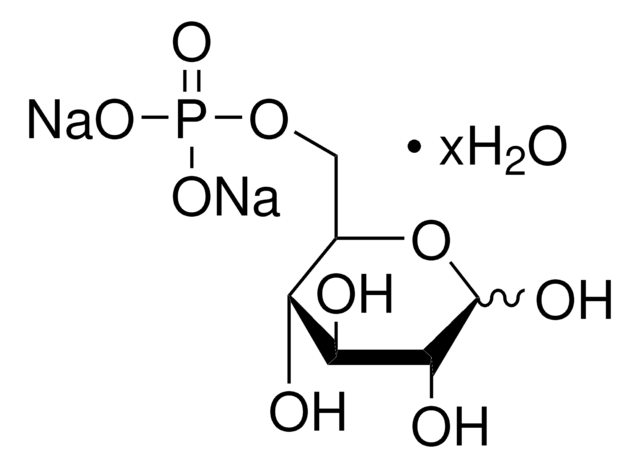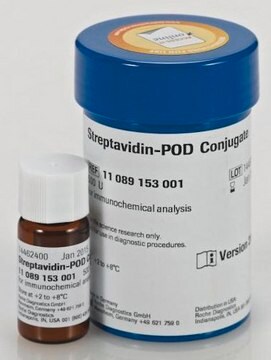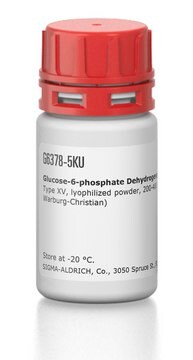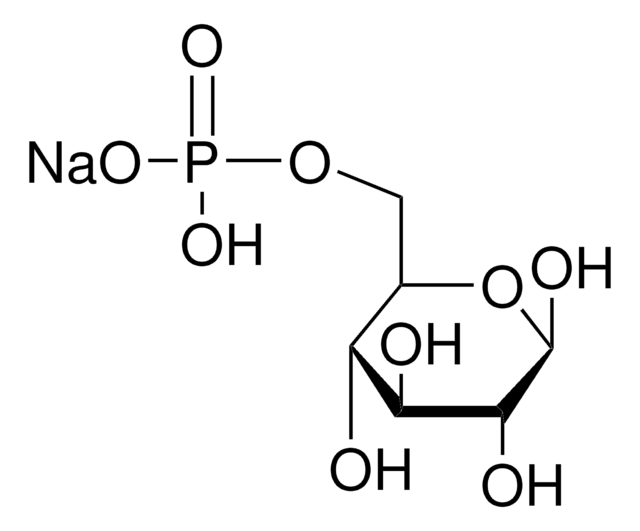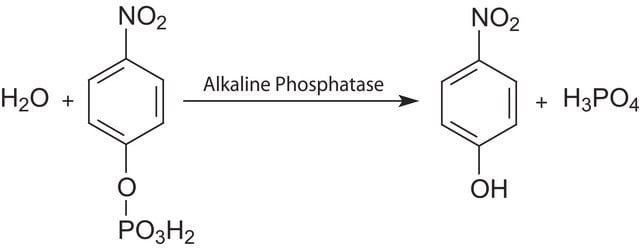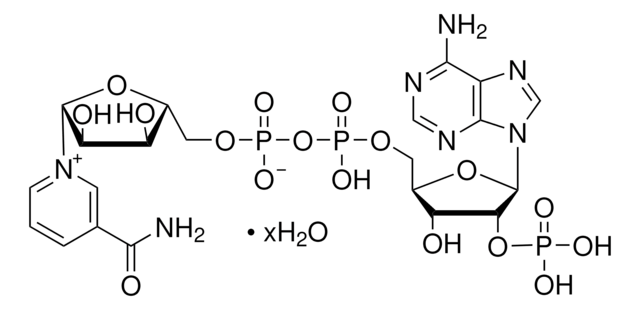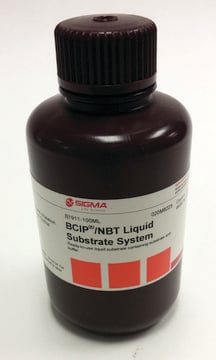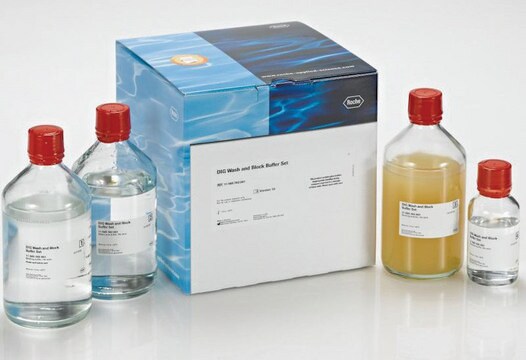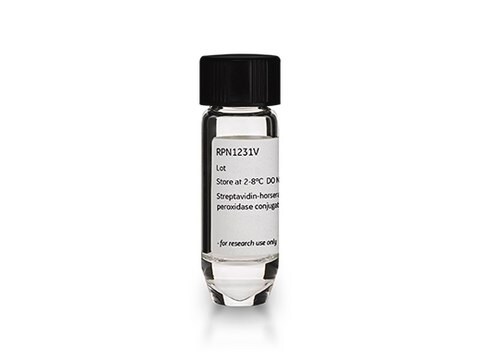Alle Fotos(1)
Wichtige Dokumente
11089161001
Roche
Streptavidin-AP-Konjugat
solution, pkg of 1 mL (1,000U)
Synonym(e):
Streptavidin
Anmeldenzur Ansicht organisationsspezifischer und vertraglich vereinbarter Preise
Alle Fotos(1)
About This Item
UNSPSC-Code:
12352200
Empfohlene Produkte
Form
solution
Qualitätsniveau
Verpackung
pkg of 1 mL (1,000U)
Hersteller/Markenname
Roche
Lagertemp.
2-8°C
Allgemeine Beschreibung
Streptavidin wird zur Herstellung von Streptavidin-AP-Konjugat kovalent an alkalische Phosphatase (AP) gekoppelt.
Alkalische Phosphatase
Alkalische Phosphatase wird häufig als Markierung in Enzym-Immunassays verwendet. AP wandelt das empfindliche Substrat X-Phosphat/NBT in ein stabiles, wasserlösliches Produkt um.
Alkalische Phosphatase
Alkalische Phosphatase wird häufig als Markierung in Enzym-Immunassays verwendet. AP wandelt das empfindliche Substrat X-Phosphat/NBT in ein stabiles, wasserlösliches Produkt um.
Anwendung
Streptavidin-AP wird zum Nachweis von biotinylierten Verbindungen verwendet:
- ELISA
- Immunhistozytochemie
- Western Blot
Physikalische Form
Lösung, stabilisiert in 50 mM Triethanolaminpuffer, 3 M NaCl, 1 mM MgCl2, 0,1 mM ZnCl2, 10 mg/mL Rinderserumalbumin, pH 7,6.
Angaben zur Herstellung
Arbeitslösung: 50–1.000 mU/mL (d. h. Stammlösung kann verdünnt werden). Die konjugierte Stammlösung in 100 mM Tris-HCl, 150 mM NaCl, pH 7,5, verdünnen.
Arbeitskonzentration: Die Arbeitskonzentration des Konjugats hängt von der Anwendung und vom Substrat ab. Die angegebenen Konzentrationen sind als Richtlinie zu verstehen.
ELISA: 50–200 mU/mL (Verdünnung 1:5000–1:20.000)
Immunhisto-/Zytochemie: 250–1.000 mU/mL (Verdünnung 1:1000–1:4000)
Western Blot: 200–500 mU/mL (Verdünnung 1:2000–1:5000)
Stabilität: Die konzentrierte Stammlösung ist bei Lagerung bei 2–8 °C bis zum auf dem Etikett aufgedruckten Verfallsdatum stabil. Nicht einfrieren!
Arbeitskonzentration: Die Arbeitskonzentration des Konjugats hängt von der Anwendung und vom Substrat ab. Die angegebenen Konzentrationen sind als Richtlinie zu verstehen.
ELISA: 50–200 mU/mL (Verdünnung 1:5000–1:20.000)
Immunhisto-/Zytochemie: 250–1.000 mU/mL (Verdünnung 1:1000–1:4000)
Western Blot: 200–500 mU/mL (Verdünnung 1:2000–1:5000)
Stabilität: Die konzentrierte Stammlösung ist bei Lagerung bei 2–8 °C bis zum auf dem Etikett aufgedruckten Verfallsdatum stabil. Nicht einfrieren!
Sonstige Hinweise
Nur für die Life-Science-Forschung. Nicht für den Einsatz in diagnostischen Verfahren geeignet.
Ähnliches Produkt
Produkt-Nr.
Beschreibung
Preisangaben
Signalwort
Warning
H-Sätze
Gefahreneinstufungen
Skin Sens. 1
Lagerklassenschlüssel
12 - Non Combustible Liquids
WGK
WGK 1
Flammpunkt (°F)
No data available
Flammpunkt (°C)
No data available
Hier finden Sie alle aktuellen Versionen:
Besitzen Sie dieses Produkt bereits?
In der Dokumentenbibliothek finden Sie die Dokumentation zu den Produkten, die Sie kürzlich erworben haben.
Kunden haben sich ebenfalls angesehen
Ablation of BMP signaling hampers the blastema formation in Poecilia latipinna by dysregulating the extracellular matrix remodeling and cell cycle turnover
Patel S, et al.
Zoology (Jena, Germany), 133, 17-26 (2019)
Daniela Röthlisberger et al.
FEBS letters, 564(3), 340-348 (2004-04-28)
Co-crystallization of membrane proteins with antibody fragments may emerge as a general tool to facilitate crystal growth and improve crystal quality. The bound antibody fragment enlarges the hydrophilic part of the mostly hydrophobic membrane protein, thereby increasing the interaction area
Manuela Sauter et al.
iScience, 25(1), 103677-103677 (2022-01-18)
Atherosclerosis is studied in models with dysfunctional lipid homeostasis-predominantly the ApoE-/- mouse. The role of antigen-presenting cells (APCs) for lipid homeostasis is not clear. Using a LacZ reporter mouse, we showed that CD11c+ cells were enriched in aortae of ApoE-/-
Johan L K Van Hove et al.
Molecular genetics and metabolism, 95(4), 201-205 (2008-11-01)
We investigated in a patient with holocarboxylase synthetase deficiency, the relation between the biochemical and genetic factors of the mutant protein with the pharmacokinetic factors of successful biotin treatment. A girl exhibited abnormal skin at birth, and developed in the
Volker Hegenauer et al.
Nature communications, 11(1), 5299-5299 (2020-10-22)
Parasitic plants of the genus Cuscuta penetrate shoots of host plants with haustoria and build a connection to the host vasculature to exhaust water, solutes and carbohydrates. Such infections usually stay unrecognized by the host and lead to harmful host
Unser Team von Wissenschaftlern verfügt über Erfahrung in allen Forschungsbereichen einschließlich Life Science, Materialwissenschaften, chemischer Synthese, Chromatographie, Analytik und vielen mehr..
Setzen Sie sich mit dem technischen Dienst in Verbindung.